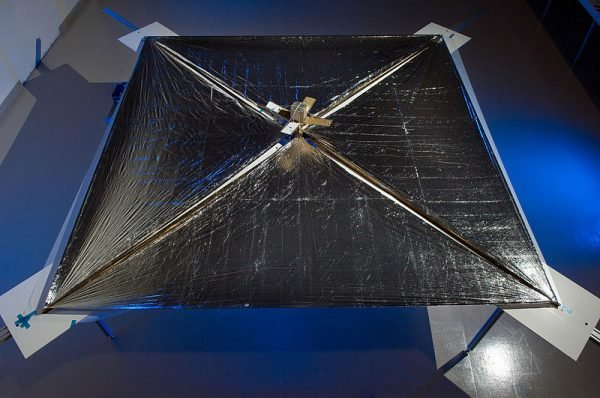Image credit: NASA
Imagine zooming through space propelled by nothing else but the light of the Sun and other stars. Science fiction? No quite!
The concept of light sailing, or solar sailing, has been around since the 17th century. No serious progress towards implementing this idea has been made until the 21st century, but now it is making its way to the science labs, simulation facilities and into space.
Light sailing technology is being developed and tested as we speak. Many scientist think that it might be humanity’s best, if not only, chance to “go interstellar”. So..
What is light sailing?
Light sailing is a way of space travel. The idea is to equip a spacecraft with a giant sail made of highly reflective material such as aluminium. When massless light particles (photons) from the Sun or another star bump into the sail, some of the photons will bounce off the surface and their momentum will be transferred to the craft. In the absence of the atmosphere this tiny “push” will be enough for moving, maneuvering and accelerating a spacecraft to a great speed over a long distance.
Keep in mind that a light sail spacecraft is propelled NOT by solar wind, like wind sail, but exclusively by the radiation pressure.
The advantages of this technology are huge! No need to produce or carry fuel for the maneuvers and unlimited propellant supplies mean that space exploration can be less expensive and we can finally go places that up until now were well out of our reach.
IKAROS: light sailing debut in 2010
Japanese Space Agency JAXA was the first organization to show that light sailing technology can work. Back in 2010 they successfully launched the first light sail spacecraft called ”Interplanetary Kite-craft Accelerated by Radiation Of the Sun”, or IKAROS for short.
The spacecraft was propelled by the sunlight and solar energy stored in its tiny solar cells provided power for the payload. The mission was designed to last 6 months, but IKAROS worked way longer. The kite-craft made its last contact with the Earth in May 2015.
LightSail 2: the upcoming 2019 launch
Not only government space agencies are interested in the light sailing. Private companies have their eyes on the technology too. The Planetary Society, an American non-government organization, is about to test their most recent crowdfunding project LightSail 2. If all goes as planned, then tomorrow, on June 24 2019, LightSail 2 spacecraft will be launched into orbit around the Earth aboard SpaceX Falcon Heavy rocket. LightSail 2 is a tiny probe about the size of a loaf of bread. Its sail, when fully deployed, is 32 square meters large.
The objective of the upcoming mission is to try and raise the orbit (i.e. distance from the Earth) of the spacecraft using only the push on the sunlight. At the end of its 60 day journey LightSail2 will plunge into the Earth’s atmosphere.
Watch the LightSail2 animation to learn more about the spacecraft and its mission.
The spacecraft’s predecessor, LightSail 1, had lots of problems during its short one month operation in 2015. Still, the Society’ pilot mission achieved its primary goal, sail deployment, and pointed out what needed to be improved.
Breakthrough Starshot: aiming for the stars
When it comes to light sailing, Breakthrough Initiatives have the most ambitious plans of all. Their starshot project is an idea-in-development to send a fleet of centimeter size spacecrafts to Alpha Centauri, the closest star system to the Sun. The nano-crafts will be accelerated to the ¼ of the speed of light by a laser beam on Earth. At that speed they will reach their destination in “just” 30 years.
By the way, the Starshot idea was featured in the children’s fiction book “The Jamie Drake equation” by Christopher Edge. You will find more information about the book and the real science facts in it in our blog post “The Jamie Drake Equation” book.
Will these pioneering attempts to sail through space eventually lead to human interstellar travel? We cannot wait to find out!
For more information
- Book our inflatable star dome to experience interstellar travel without even leaving the Earth!
- Send you questions, comments and ideas to our portable planetarium team. We would love to hear from you!

